

Better Ways To Give It Away. Our distrust is very expensive.
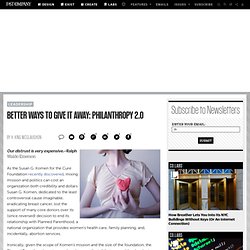
--Ralph Waldo Emerson As the Susan G. Komen for the Cure Foundation recently discovered, mixing mission and politics can cost an organization both credibility and dollars. Susan G. Komen, dedicated to the least controversial cause imaginable, eradicating breast cancer, lost the support of many core donors over its (since reversed) decision to end its relationship with Planned Parenthood, a national organization that provides women’s health care, family planning, and, incidentally, abortion services. Ironically, given the scope of Komen’s mission and the size of the foundation, the Planned Parenthood grants somehow became the tail that wagged the dog. Komen’s decision was widely interpreted to be politically motivated, and this perception is at the crux of the organization’s debacle. Increasingly, affluent donors are answering these questions by taking control of their own philanthropy. As Americans, we are a famously generous people. Carleton. Blended value (slideshare)
Accountingforsocial impact (Carleton) Why Measure? Nonprofits use metrics to show that they are efficient. But what if donors don’t care? How do we define and measure social impact? EVPA Workshop on Social Impact Measurement. La Fundación Corresponsables lanza los V Premios Corresponsables en España y Latinoamérica consolidando en esta edición el marcado carácter internacional que adquirieron en la pasada, para así conseguir una aún mayor difusión y repercusión, lo que interesará a vuestras organizaciones, tanto si están ya presentes en varios países como si lo piensan estar en el futuro.
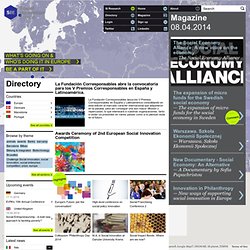
Can Social Impact really be measured? Really? Can social impact really be measured?

I've been thinking about Rob Edwards's comment on my last blog and have decided it deserves a blog of its own. In his response Rob, reflecting on Magic Breakfast's call for £13 million pounds worth of investment in a social impact bond that offers £28 million in savings from the additional Government expenditure needed to address the social problems of children too hungry to learn, Rob said, "..this is the whole problem with social enterprise.
The returns can be somewhat ephemeral, and an awful lot of time and money goes into setting up organisations rather than actually delivering services that people want. " Is this the case? Is measuring social impact ephemeral and therefore too academic to bring into a discussion about investment? Just after the election I had a meeting with the man put in charge of regeneration in a major Government department, he asked me, "How do we create regeneration and cut spending? ". Logical Outcomes. Measuring the economic impact of social innovation – MaRS: Building Canada's next generation of growth companies. By Lisa Torjman @ MaRS November 14, 2008 How do we measure social impact?
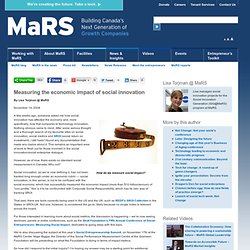
A few weeks ago, someone asked me how social innovation has affected the economy and, more specifically, how that compares to technology innovation. Nothing obvious came to mind. After some serious thought and a thorough search of my favourite sites on social innovation, social metrics and SROI (social return on investment), I still hadn’t found any documentation that made any claims about it.
However, as of now, there exists no standard social measurement in Canada. Social innovation, as we’re now defining it, has not been tracked long enough under an economic rubric — social innovation, in this sense, is not to be confused with the social economy, which has successfully measured the economic impact (more than $10 billion/annum) of “non-profits.” That said, there are tools currently being used in the US and the UK, such as REDF’s SROI Collection in the States or SROI-UK.
Enough Talk, More Do. If you’re a nonprofit news junkie, you know it’s nearly impossible to go a day without reading or hearing the words “innovation” and “impact.”
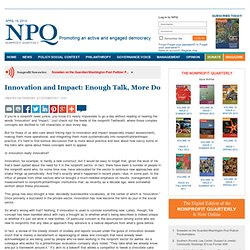
Just check out the feeds of the nonprofit Twitteratti, where those complex concepts are distilled to 140 characters or less every day. But for those of us who care about linking rigor to innovation and impact (especially impact assessment), making them more operational, and integrating them more systematically into nonprofit/philanthropic practice, it’s hard to find serious discussion that is more about practice and less about how savvy some of the folks who opine about these concepts want to appear.
Is innovation really innovative? Innovation, for example, is hardly a new construct; but it would be easy to forget that, given the level of ink that’s been spilled about the need for it in the nonprofit sector. This group has also brought a new, decidedly businesslike vocabulary, at the center of which is “innovation.” Measuring your impact. By Robin Cory @ MaRS March 24, 2010 How to measure "good"?
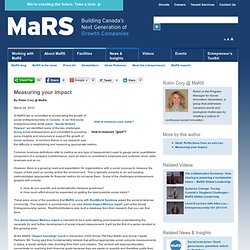
At MaRS we’re committed to accelerating the growth of social entrepreneurship in Canada. In our first social entrepreneurship white paper, “Social Venture Finance” we identified some of the key challenges facing social entrepreneurs and committed to providing some insights and resources to support the growth of social ventures. A common theme in our research was the difficulty in establishing and measuring appropriate metrics. Common business definitions refer to metrics as any type of measurement used to gauge some quantifiable component of a company’s performance, such as return on investment, employee and customer churn rates, revenues and so on.
Measuring social impact and SROI. Measuring social impact and return on investment – The growing pressure for evidence: A unique South African Perspective: Introduction: How to measure the value and results of corporate social investment remains one of CSI Practitioners’ greatest challenges.
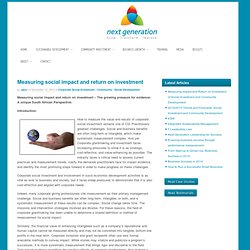
Social and business benefits are often long-term or intangible, which make systematic measurement complex. How to measure social impact. One of the key concepts in approaching social impact assessment theory and practice is the difference between frameworks and tools.
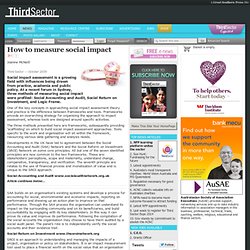
Frameworks provide an overarching strategy for organising the approach to impact assessment, whereas tools are designed around specific activities. The three methods presented here are frameworks, subsequently providing ‘scaffolding’ on which to build social impact assessment approaches. Tools specific to the work and organisation will sit within the framework, resourcing various data gathering and analysis needs. Developments in the UK have led to agreement between the Social Accounting and Audit (SAA) Network and the Social Reform on Investment (SROI) Network on some core principles.
All but one of the seven identified principles are now common to the two frameworks. Social Accounting and Audit www.socialauditnetwork.org.uk Article continues below… Social Return on Investment www.thesroinetwork.org Logic Frame. Analysis of economic impact. Why Measuring Impact Remains an Elusive Goal.